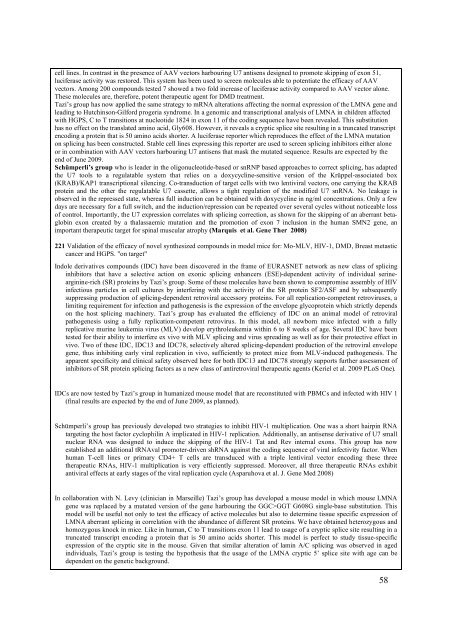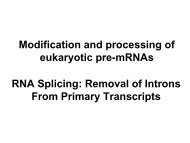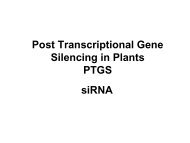You also want an ePaper? Increase the reach of your titles
YUMPU automatically turns print PDFs into web optimized ePapers that Google loves.
cell lines. In contrast in the presence of AAV vectors harbouring U7 antisens designed to promote skipping of exon 51,luciferase activity was restored. This system has been used to screen molecules able to potentiate the efficacy of AAVvectors. Among 200 compounds tested 7 showed a two fold increase of luciferase activity compared to AAV vector alone.These molecules are, therefore, potent therapeutic agent for DMD treatment.Tazi’s group has now applied the same strategy to mRNA alterations affecting the normal expression of the LMNA gene andleading to Hutchinson-Gilford progeria syndrome. In a genomic and transcriptional analysis of LMNA in children affectedwith HGPS, C to T transitions at nucleotide 1824 in exon 11 of the coding sequence have been revealed. This substitutionhas no effect on the translated amino acid, Gly608. However, it reveals a cryptic splice site resulting in a truncated transcriptencoding a protein that is 50 amino acids shorter. A luciferase reporter which reproduces the effect of the LMNA mutationon splicing has been constructed. Stable cell lines expressing this reporter are used to screen splicing inhibitors either aloneor in combination with AAV vectors harbouring U7 antisens that mask the mutated sequence. Results are expected by theend of June 2009.Schümperli’s group who is leader in the oligonucleotide-based or snRNP based approaches to correct splicing, has adaptedthe U7 tools to a regulatable system that relies on a doxycycline-sensitive version of the Krüppel-associated box(KRAB)/KAP1 transcriptional silencing. Co-transduction of target cells with two lentiviral vectors, one carrying the KRABprotein and the other the regulatable U7 cassette, allows a tight regulation of the modified U7 snRNA. No leakage isobserved in the repressed state, whereas full induction can be obtained with doxycycline in ng/ml concentrations. Only a fewdays are necessary for a full switch, and the induction/repression can be repeated over several cycles without noticeable lossof control. Importantly, the U7 expression correlates with splicing correction, as shown for the skipping of an aberrant betaglobinexon created by a thalassaemic mutation and the promotion of exon 7 inclusion in the human SMN2 gene, animportant therapeutic target for spinal muscular atrophy (Marquis et al. Gene Ther <strong>2008</strong>)221 Validation of the efficacy of novel synthesized compounds in model mice for: Mo-MLV, HIV-1, DMD, Breast metasticcancer and HGPS. "on target"Indole derivatives compounds (IDC) have been discovered in the frame of <strong>EURASNET</strong> network as new class of splicinginhibitors that have a selective action on exonic splicing enhancers (ESE)-dependent activity of individual serinearginine-rich(SR) proteins by Tazi’s group. Some of these molecules have been shown to compromise assembly of HIVinfectious particles in cell cultures by interfering with the activity of the SR protein SF2/ASF and by subsequentlysuppressing production of splicing-dependent retroviral accessory proteins. For all replication-competent retroviruses, alimiting requirement for infection and pathogenesis is the expression of the envelope glycoprotein which strictly dependson the host splicing machinery. Tazi’s group has evaluated the efficiency of IDC on an animal model of retroviralpathogenesis using a fully replication-competent retrovirus. In this model, all newborn mice infected with a fullyreplicative murine leukemia virus (MLV) develop erythroleukemia within 6 to 8 weeks of age. Several IDC have beentested for their ability to interfere ex vivo with MLV splicing and virus spreading as well as for their protective effect invivo. Two of these IDC, IDC13 and IDC78, selectively altered splicing-dependent production of the retroviral envelopegene, thus inhibiting early viral replication in vivo, sufficiently to protect mice from MLV-induced pathogenesis. Theapparent specificity and clinical safety observed here for both IDC13 and IDC78 strongly supports further assessment ofinhibitors of SR protein splicing factors as a new class of antiretroviral therapeutic agents (Keriel et al. 2009 PLoS One).IDCs are now tested by Tazi’s group in humanized mouse model that are reconstituted with PBMCs and infected with HIV 1(final results are expected by the end of June 2009, as planned).Schümperli’s group has previously developed two strategies to inhibit HIV-1 multiplication. One was a short hairpin RNAtargeting the host factor cyclophilin A implicated in HIV-1 replication. Additionally, an antisense derivative of U7 smallnuclear RNA was designed to induce the skipping of the HIV-1 Tat and Rev internal exons. This group has nowestablished an additional tRNAval promoter-driven shRNA against the coding sequence of viral infectivity factor. Whenhuman T-cell lines or primary CD4+ T cells are transduced with a triple lentiviral vector encoding these threetherapeutic RNAs, HIV-1 multiplication is very efficiently suppressed. Moreover, all three therapeutic RNAs exhibitantiviral effects at early stages of the viral replication cycle (Asparuhova et al. J. Gene Med <strong>2008</strong>)In collaboration with N. Levy (clinician in Marseille) Tazi’s group has developed a mouse model in which mouse LMNAgene was replaced by a mutated version of the gene harbouring the GGC>GGT G608G single-base substitution. Thismodel will be useful not only to test the efficacy of active molecules but also to determine tissue specific expression ofLMNA aberrant splicing in correlation with the abundance of different SR proteins. We have obtained heterozygous andhomozygous knock in mice. Like in human, C to T transitions exon 11 lead to usage of a cryptic splice site resulting in atruncated transcript encoding a protein that is 50 amino acids shorter. This model is perfect to study tissue-specificexpression of the cryptic site in the mouse. Given that similar alteration of lamin A/C splicing was observed in agedindividuals, Tazi’s group is testing the hypothesis that the usage of the LMNA cryptic 5’ splice site with age can bedependent on the genetic background.58







